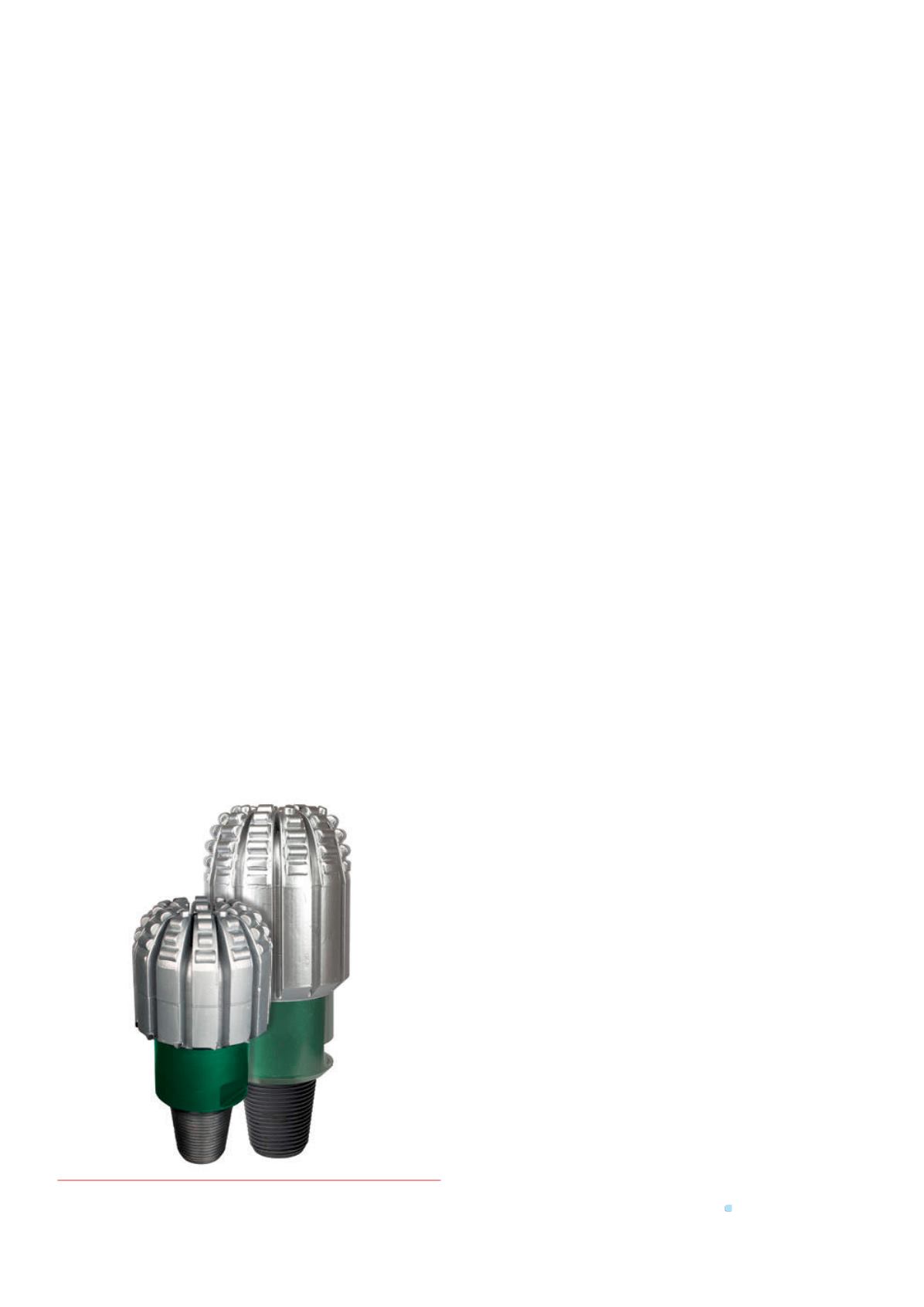
34 |
Oilfield Technology
June
2016
20 to 55 kPSI. As a result, bit life and ROP have been greatly
limited, with multiple trips from 4000 m and deeper. Typically,
three to five bits are needed to drill the section.
The latest record run bit drilled 859 m (2818 ft) at 2.15 m/hr
(7 ft/hr). The performance saved the operator eight days from
the planned schedule, including the elimination of two trips and
two bit changes.
In addition to the 8 ⅜ in. runs, a 5
⅞
in. F1213G Fusion bit
turned in similar record performance in the Salakh Field. The bit
drilled a total of 440 m (1442 ft) at an average ROP of 1.18 m/h
(3.86 ft/h), to eliminate trip time and costs for three to four
conventional bits.
Bit technology
DI bits are a common tool for improving drilling performance in
hard, abrasive formations. Their use has increased with greater
understanding of DI bit performance and wear, but performance
can still be inconsistent based on variations in rock properties,
such as mineralogy, bit segment properties including matrix
hardness, wear status, concentration and diamond size.
Field results and dull analysis have shown that a complex
wear process is a key factor contributing to DI bit performance.
This wear results in the continuous evolution of the cutting face
and the exposure of new diamonds. In the process, the depth
of the cut results in different wear mechanisms – shallow cuts
produce diamond polishing while deeper cuts produce diamond
fracturing, diamond losses, and matrix abrasion. Impregnated
bits have historically been dedicated designs built to address
both hard and abrasive formations.
A primary driver in the recent DI bit advances is computer
modelling that builds on advances in materials and
manufacturing to target specific formation characteristics.
The resulting designs have shown significant improvements in
performance over conventional DI bits built to a broader design
standard.
The design advance developed by Varel recognises the
strong relationship between the volume of diamond available
to drill and bit durability. This relationship is determined by
the volume of rock removed versus the volume of diamond
losses. Manipulating the material changes this ratio to enable
fine-tuning of drilling efficiency. Adjustments are made based
on a material performance evaluation after bit use. This
quantitative analysis is focused on whole stones, crushed stones,
and pulled stones in the cutting structure to determine a balance
between matrix hardness, diamond size, concentration, and
distribution.
To balance durability and ROP efficiency for a specific
application, Varel reviews the design and material selection
to address a broad scope of considerations including diamond
distribution, sintered segment shapes and composition,
hydraulics, diamond grades, and thermo mechanical and
chemical damage.
Diamond distribution is crucial to bit performance. It is
important to avoid diamond aggregate that can result in partial
coverage with areas of low diamond concentration. Pelletising
the diamond results in even diamond distribution, provides
protection during heat cycles, and improves diamond matrix
bonding.
Sintered segments are manufactured using a HIP process to
produce customised shapes that accommodate design geometry
and optimise diamond volume in a given area. HIP diamond size,
concentration, and matrix hardness can also be fine-tuned based
on their profile location (inner cone, nose, or outer cone).
Varel’s SPOT-DN™ bit design programme is used to address
specific durability and penetration rate targets for the formation.
The design process considers diamond volume distribution
over the profile (blade material + insert shapes) and material
characteristics such as matrix hardness, diamond size, and
diamond concentration.
Cutting structure considerations include segment shape. Using
individual segments of various shapes allows optimisation of the
diamond distribution all along the bit profile. For example, using a
drop shape segment allows greater segment height, which yields
better area durability because the height of the blade has more
HIP segment material in the critical area of the nose taper.
In the case of the Oman applications cited in this article,
the shape and geometry of the HIP segment was fine-tuned
to achieve better coverage on the nose and shoulder of the
bit and increase the ratio of sintered diamond (HIP segment)
against a handpack-impregnated matrix. Carat distribution was
monitored to avoid weak spots that could result in an early ring
out wear progression.
The bit design process also considers how cooling and
cleaning are affected allowing necessary changes to optimise
fluid distribution and minimise cutting traps.
In addition to design parameters, material selection can
be also tailored for the application. As with all diamond-based
material, design efforts can be compromised by diamond
degradation. The primary challenge is temperature, which
causes both mechanical and chemical degradation. This is
addressed through a specific low temperature manufacturing
process.
Conclusion
Optimising the performance of DI bits in a fast, precise process
is yielding significant improvements in drilling hard and/or
abrasive formations. Using specialised technologies to enhance
durability and ROP performance, the application-specific
Fusion DI bits are achieving new levels of field performance that
strongly validate the customised design.
Figure 4.
FusionDI bits designed for the application outperformed
offsets.


